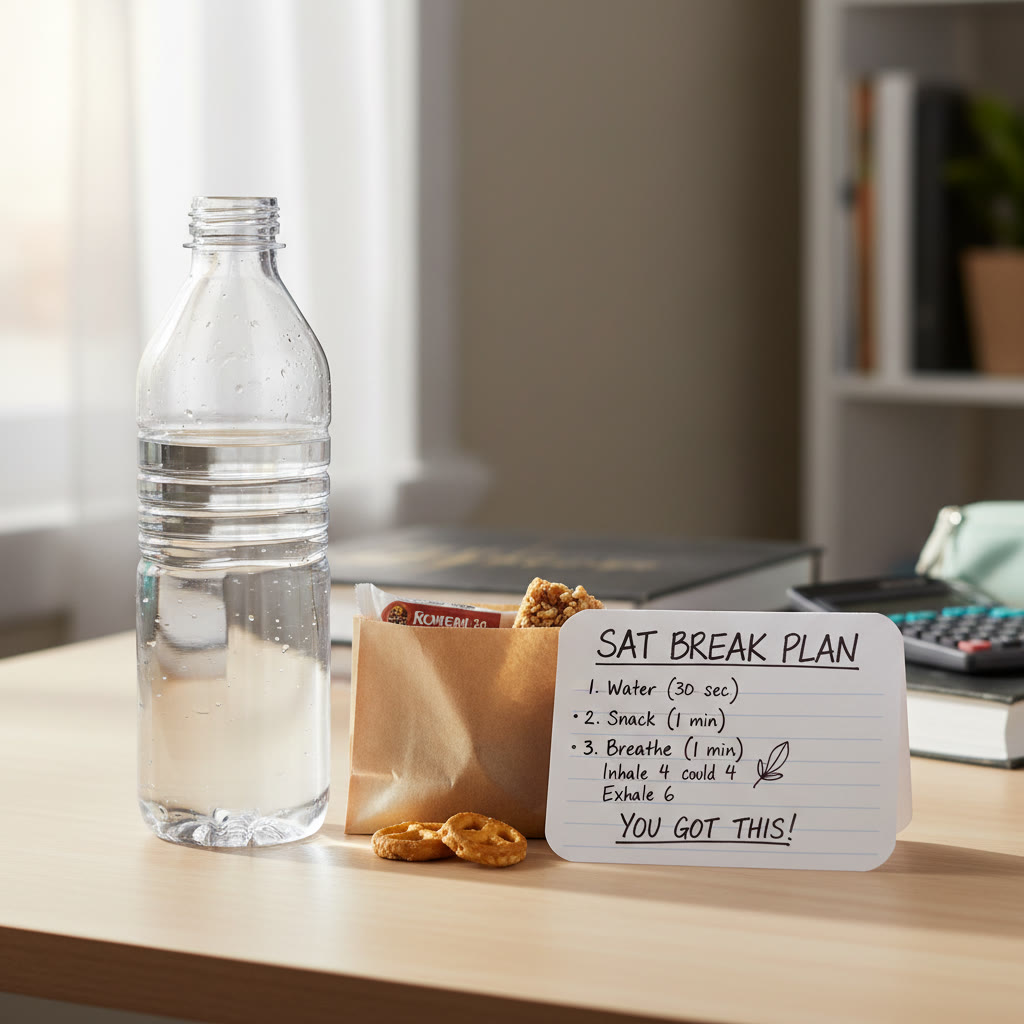Why breaks matter: more than just time off
Imagine you’re in the middle of a long run. You don’t sprint every mile — you vary your pace, take a drink, and adjust your breathing. The SAT is similar: it’s an endurance challenge for your brain. Breaks aren’t a sign of weakness; they’re strategic pit stops that keep your thinking sharp and your energy steady.
Students often ask: “If the break is only 10 minutes, can it really help?” The short answer is yes. A well-used break can undo mental fatigue, reduce anxiety, and restore attention so you return to the test with clearer thinking. The trick is knowing what to do in those minutes — and what to avoid.
Understand the kinds of mental fatigue you face
Not all tiredness feels the same. Identifying the type of fatigue helps you pick the right reset.
- Attentional fatigue: You’re zoning out or re-reading the same sentence. Tiny resets that refresh working memory help.
- Decision fatigue: You’re overwhelmed by choices or unsure about how to approach a problem. Simplifying and planning during breaks restores clarity.
- Emotional fatigue: Anxiety, panic, or frustration take over. Calming practices and micro-exposures decrease emotional spikes.
- Physical fatigue: Aching hands, stiff neck, or shallow breathing. Movement and hydration are the cure.
What NOT to do on a short SAT break
Short breaks (the official break during the SAT is typically about 10 minutes, though exact timing can vary) are precious. Avoid activities that eat time without helping focus.
- Don’t binge social media: Scrolling activates novelty-seeking and makes it harder to re-focus.
- Avoid heavy meals: Large, greasy foods can cause post-snack drowsiness.
- Don’t cram new material: Trying to learn formulas or rules in the break increases cognitive load and stress.
- Avoid deep conversations that spike emotions — both excitement and stress can derail concentration.
Three proven reset routines for a 10-minute test break
Choose a routine that feels natural and practice it in mock tests so it becomes automatic on test day.
1. The Micro-Movement Reset (3–5 minutes)
Use movement to get blood flowing and release tension.
- 0:00–1:00 — Stand up, stretch shoulders and neck. Roll your shoulders 6–8 times each direction.
- 1:00–2:30 — Walk briskly around the room. Swing arms gently to increase heart rate.
- 2:30–4:00 — Do two sets of 10 bodyweight squats or heel raises to wake your core and legs.
- 4:00–5:00 — Shake out hands and wrists; breathe deeply before sitting.
Why it works: movement increases oxygenation and reduces cortisol, making it easier to return to sustained attention.
2. The 5-Minute Cognitive Reset
Perfect when you need to clear mental clutter and get back to problem-solving.
- 0:00–1:00 — Close your eyes; do three box breaths (inhale 4s, hold 4s, exhale 4s).
- 1:00–3:00 — Run a quick mental checklist: “What section did I finish? What do I need for the next section?” Keep it to 3 bullets max.
- 3:00–5:00 — Preview the first two questions of the next section on the test booklet (if allowed) or plan your strategy: time per question, easy-questions-first, and any tools you’ll use.
Why it works: structured reflection prevents aimless worry and primes task-relevant goals.
3. The Calm-Down Protocol (for anxiety spikes)
When nerves get loud, this routine lowers heart rate and restores control.
- 0:00–1:00 — Grounding: name 5 things you can see, 4 things you can touch, 3 things you can hear.
- 1:00–3:00 — Progressive relaxation: tense and release major muscle groups (feet, legs, shoulders).
- 3:00–5:00 — Imagine a simple victory: finishing the section calmly and checking the last five answers.
Why it works: calming the autonomic nervous system reduces working-memory interference from anxiety.
Longer practice-session breaks: scaling the reset
When you’re studying for hours at home, the break strategies expand. You have time for deeper resets that build stamina.
- Pomodoro-style: 25 minutes study, 5 minute break; repeat four times, then a 20–30 minute break.
- Active learning breaks: After a focused session on math, use a break to teach a friend or explain a concept aloud (this consolidates memory).
- Nature breaks: Spend 15–30 minutes outside. Sunlight, fresh air, and change of scenery boost cognitive functioning.
Practical, test-day checklist for using breaks well
Print this checklist or rehearse it in your mock test so the behavior becomes automatic.
- Pack a small, light snack (banana, trail mix, or a granola bar) and a water bottle in clear packaging.
- Label your break routine before the test: Micro-Movement, Cognitive Reset, or Calm-Down.
- Time yourself once during a practice test so you know what fits into 10 minutes.
- Practice the breathing and grounding exercises until they feel effortless.
- Have a simple one-line plan to preview the next section (e.g., “Math: start with grid-in questions”) — no new learning.
Quick examples: how real students use breaks
Stories are often more memorable than rules. Here are three student snapshots to inspire practical application.
Emily — the re-reader
Problem: Emily kept re-reading reading-passage lines and losing time. During a practice test she tried the 5-Minute Cognitive Reset: deep breathing and a two-bullet plan to “identify passage central idea” and “mark confusing lines to come back to.” After the break she skimmed faster, used the plan, and improved accuracy by focusing on structure rather than obsessing over wording.
Ravi — the anxious test-taker
Problem: Ravi’s heart raced halfway through math. He learned the Calm-Down Protocol and practiced it during proctored mocks. On test day, he did a one-minute grounding exercise during the official break and returned calmer, with fewer careless errors.
Jasmine — the crammer
Problem: Jasmine wanted to cram formulas during the break. Her tutor at Sparkl helped her design a better plan: a 2-minute memory cue review of a single tricky formula followed by movement. The structured mini-review increased recall without adding stress.
Use tools smartly: timers, cues, and habit anchors
Technology can help, but only if it’s disciplined.
- Use a simple watch or phone timer during practice so you know what fits in 10 minutes. On test day you’ll rely on the proctor’s clock, so practice with both.
- Create a 3-word cue that anchors your break routine. Example: “Breathe, Move, Plan.” On break, say it once and follow the steps.
- Practice routines until they become automatic. When stress hits, automatic routines reduce decision fatigue.
How to personalize your break plan (and where Sparkl fits in)
No two brains are identical: some students revive best with short bursts of movement; others need quiet grounding. That’s why personalization matters. Working with a skilled tutor or coach helps you identify which routine produces the biggest gains in practice tests.
Sparkl’s personalized tutoring and benefits — 1-on-1 guidance, tailored study plans, expert tutors, and AI-driven insights — can help you experiment faster. A tutor can watch you during a mock test, recommend the right break routine for your anxiety and attention profile, and adjust plans over several practice exams so the approach is optimized for your real test-day performance.
Sample weekly practice plan that trains reset skills
Integrate break practice into your study schedule so it’s automatic under pressure. Below is a simple seven-day cycle to train both short-test breaks and longer study breaks.
| Day | Focus | Break practice | Goal |
|---|---|---|---|
| Monday | Reading (timed sections) | 5-minute Cognitive Reset during mock | Reduce re-reading and improve passage mapping |
| Tuesday | Math (no-calculator) | Micro-Movement after 50 minutes | Maintain speed and accuracy late in the section |
| Wednesday | Writing & Language | Calm-Down protocol if anxious | Lower stress during editing tasks |
| Thursday | Full practice test (timed) | Full 10-minute break simulation | Automate test-day routine |
| Friday | Targeted drills | Short outdoor break (15–20 min) | Boost consolidation and creativity |
| Saturday | Review errors | Teaching-back break: explain an error to a peer | Deepen understanding |
| Sunday | Light practice + rest | Unstructured restorative break (walk/nap) | Recover and avoid burnout |
Mini-practices you can do anywhere (30–90 seconds)
These micro-practices are tiny, fast, and valuable during short breaks or moments between sections.
- Two-count breath: inhale for 3, exhale for 3 — repeat 6 times.
- Eye reset: Look up at a distant object for 20 seconds to relax eye muscles after staring at text.
- Affirmation anchor: Say one rehearsed sentence: “One question at a time.” It moves focus from outcomes to process.
- Palm press: Press palms together for 10 seconds, then relax; it increases body awareness and lowers tension.
Measuring success: how to know if your break strategy works
Track concrete metrics in practice tests rather than feelings alone.
- Time-to-focus: How many seconds until you can read a paragraph without re-reading?
- Error pattern change: Do careless mistakes drop after using a break routine?
- Section pacing: Are you completing sections at planned speed more consistently?
- Emotional curve: Does your average anxiety score (scale 1–10) after breaks decrease over weeks?
Keep a simple log. After each practice test record which break routine you used and two quick numbers: time-to-focus and error-savings. Over 4–6 practice tests you’ll see trends that justify keeping or changing the routine.
FAQs: short, practical answers
Can I eat during the official SAT break?
Yes — a small snack and water are fine and recommended to maintain blood sugar. Avoid messy or strong-smelling foods. Practice the snack in mocks to see how it affects your alertness.
What if I panic and can’t calm down in 10 minutes?
Train the Calm-Down Protocol until it becomes automatic. If panic persists, tell the test supervisor; they are trained to help. Also, build longer relaxation sessions into your weekly plan so panic becomes rare.
Should I study formulas during the break?
Generally no. If you must, limit to a single, well-rehearsed mnemonic for 60–90 seconds. The goal is reset, not cram.
Final thought: make breaks part of your SAT skill set
Top performers don’t just master content — they master themselves. The ability to reset focus during breaks is a psychological and practical skill you can train. Treat breaks as structured interventions: plan them, practice them, and measure them. Over time they will save you time, reduce mistakes, and protect your energy.
And remember: you don’t have to figure it all out alone. Sparkl’s personalized tutoring can help tailor break strategies to your unique profile — combining 1-on-1 guidance, tailored study plans, expert tutors, and AI-driven insights so your break routine is optimized for how you think and perform. Practice your reset plan until it becomes second nature, and you’ll walk into the SAT ready to focus, not frazzled.















No Comments
Leave a comment Cancel